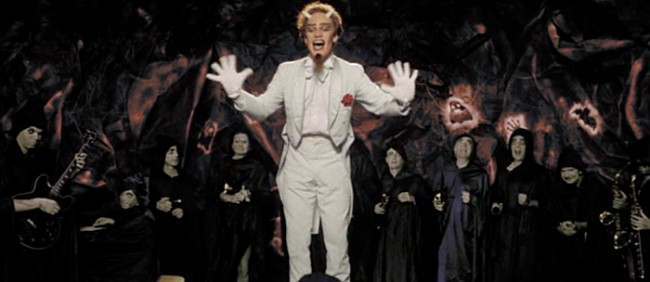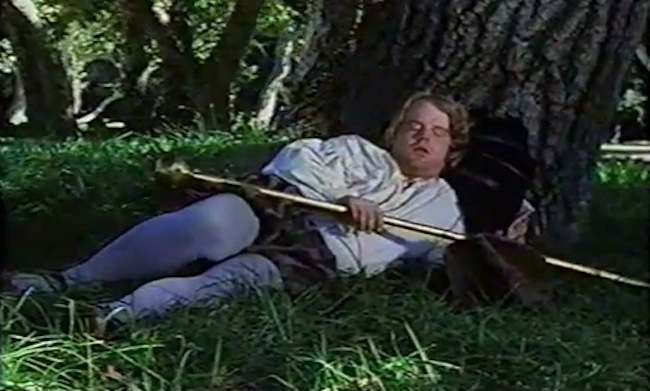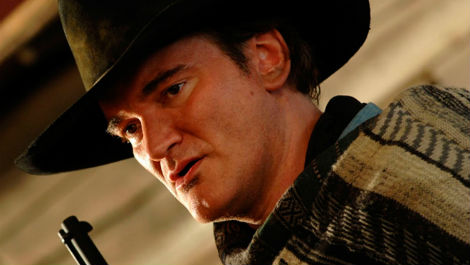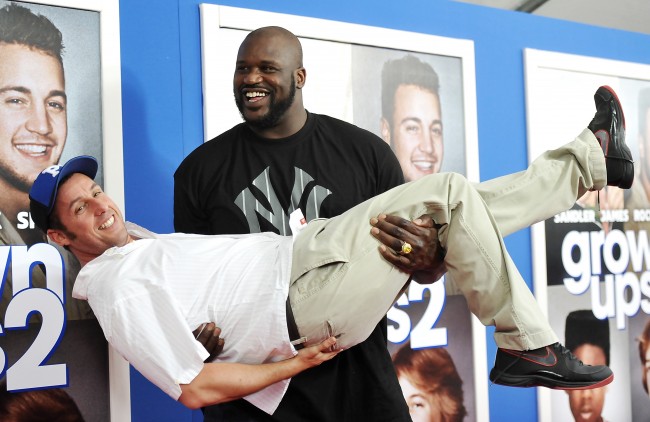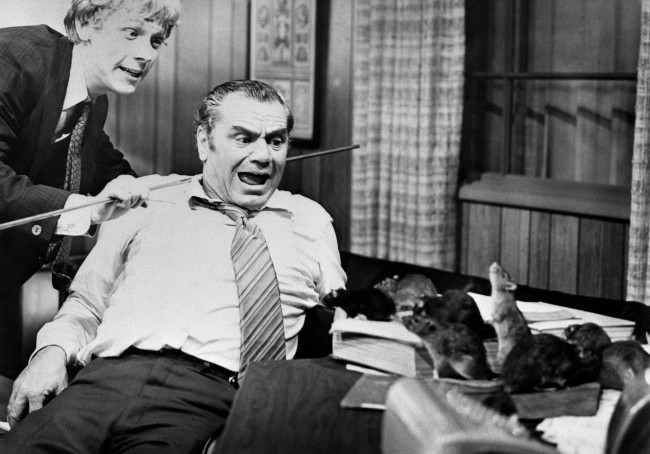Film Category
Includes cinema reviews and trailers for upcoming films. A digest of the best and worst interviews on movies and cinema.
1940: Hattie McDaniel’s Stirring Academy Award Winning Speech As The First Black Oscar Winner
ON February 29, 1940, Hattie McDaniel became the first African American to win an Academy Award, winning the Best Supporting Actress Oscar for giving life to Mammy, the Gone with the Wind house servant. Fay Bainter heralded McDaniel by telling the audience that the gong “opens the doors of this room, moves back the walls, and enables us to embrace the whole of America….”
Read the rest of this entry »
Shaken Not Stirred: Five Great Character Moments in the Roger Moore James Bond Era
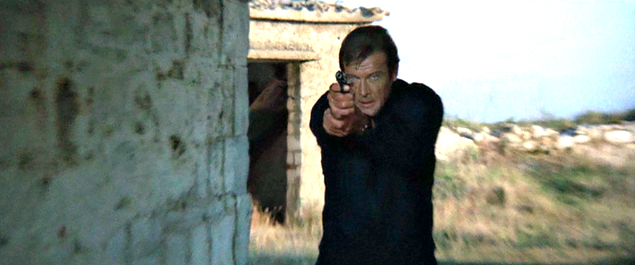
I VERY happily grew up with Sir Roger Moore in the role of Ian Fleming’s James Bond, and thus maintain a deep well of affection and nostalgia for his seven films…even if some Bond fans do not
Moore’s epoch as Agent 007 isn’t usually considered the most creatively fertile time in the franchise’s history, in part because the Bond films of the day pursued “hot” movie trends instead of initiating them, as had been the case in the 1960s.
To wit, the Bond movies of the Moore era attempted to jump on the bandwagon of Blaxploitation cinema (Live and Let Die [1973]), martial arts/Kung-Fu films (The Man with the Golden Gun [1974]), and even the Star Wars craze (Moonraker [1979]).
Despite the fact that Bond films of this time period seem desperate to pinpoint some — any — pop culture relevance, the Roger Moore efforts nonetheless boast some surprising character moments that could have been ripped straight from the novels…and Fleming’s literary descriptions of the character.
For instance, at least two films of the Roger Moore era (The Spy Who Loved Me and For Your Eyes Only) make explicit mention of the character’s tragic history — namely his dead wife, Tracy — a background that the last Connery film, Diamonds are Forever (1971) totally ignored.

Although it is undeniable that some James Bond films of the Roger Moore indeed tread heavily into unfortunate slapstick comedy (see: the pigeon doing a double-take at a gondola-turned-hovercraft in Moonraker), the actor’s finest moments in the famous role arrive not when he is called upon to play scenes broadly or cheekily, but rather when he is tasked with expressing Bond’s humanity.
Some of these “human” moments are small, even throwaway ones, but each one reminds the audience that 007 is not just a superhuman quipster in a white-dinner jacket. He’s still a man who bleeds, sweats, and struggles.
In chronological order then, here are five character moments from the James Bond Era of Roger Moore:
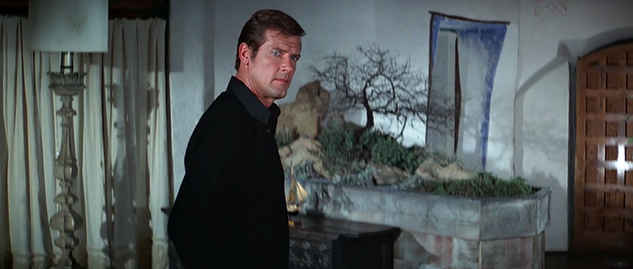
From The Spy Who Loved Me (1977): Bond talks to agent Triple XXX (Barbara Bach) about the fact that he murdered her lover.
The Spy Who Loved Me sees British and Russian intelligence join up to solve the mystery of several missing nuclear submarines. Britain’s finest, Bond, and Russia’s – XXX — join forces, and trace the missing subs back to a man named Stromberg (Curt Jurgen).
In a scene set in Sardinia, where Stromberg is headquartered, XXX confronts Bond about the fact that he may have murdered her lover three weeks earlier, on an unconnected assignment.
Bond turns away from XXX (and the audience), before he answers her accusation. Finally, he tells her that it’s hard to know who you kill when you’re racing on skis at 40 miles an hour…but yes, he did kill her lover. At this point, she informs Bond that after their mission is done, she will murder him.
This scene reminds the audience both of the constant danger in Bond’s profession, and its emotional toll upon him. Moore doesn’t rush the scene, or play it lightly. Instead, he takes his time with Bond’s response, giving us time to wonder how Bond will answer. It’s a balancing act for 007, because if he tells XXX the truth, their mission together will be imperiled. But he also feels he owes her the truth…so he gives it to her.
Bond’s sense of duty and moral code is on display in this scene, and Moore gets that aspect of the character absolutely right.
The longer that Bond is in the business of killing people, the more bodies will pile up, and the more angry spouses or family members he will be forced to confront. From this scene, we understand very clearly how Bond’s profession separates him from other people, even from other people in the spy business.
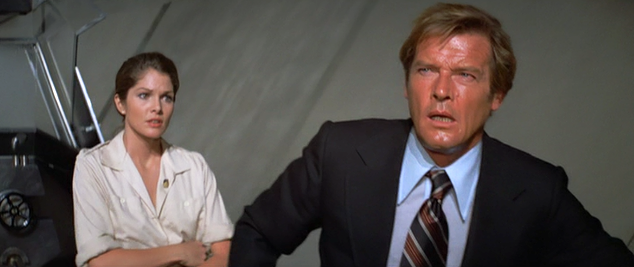
From Moonraker (1979): A rattled Bond — nearly pulped in a sabotage training centrifuge — pushes away Dr. Holly Goodhead (Loise Chiles) as she tries to help him.
This is an almost throwaway moment, but it occurs early in the 1979 film. Bond is visiting the complex of industrialist Hugo Drax (Michael Lonsdale), and Drax has secretly ordered that “some harm” come to him on a tour of the facility.
Dr. Holly Goodhead – secretly a CIA agent — convinces Bond to try out a training centrifuge, but then steps away, unwittingly leaving the villainous henchman Chang (Toshira Suga) to sabotage the machinery, and nearly kill Bond.
An apologetic Goodhead returns after Bond has disabled the deadly machine, and worriedly asks 007 what happened.
Instead of answering, he staggers out of the centrifuge, pushes her aside roughly, and is clearly pissed.
He doesn’t want to talk.
He doesn’t want to relate.
He’s angry, and this moment reveals that Moore’s Bond isn’t always suave or slick, or on the make. This is one of the few times in the Moore films that we see Bond genuinely ruffled, and knocked off-kilter.
In this moment, audiences see a hurt and angry Bond, one who momentarily rejects civility and who hasn’t yet restored his façade of charm.
It’s a telling — if brief — moment for the character. The ever-present mask of composure falls away.
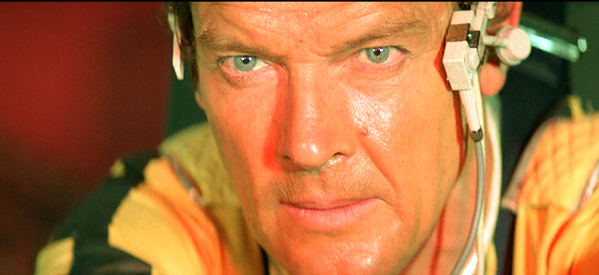
From Moonraker (1979): Bond saves 100,000 people from nerve gas…without quipping.
At the end of Moonraker, Bond and Goodhead board a space shuttle, Moonraker 5, and attempt to destroy three globes in Earth orbit.
If these globes re-enter the atmosphere, they’ll spew toxic nerve gas across whole continents. Bond destroys two without breaking a sweat, but can’t draw a bead on the third and final canister. He must switch to “manual” control to target it when things get rough.
Meanwhile, both the globe and the shuttle are making bumpy re-entry…
Now, on first blush, this moment might seem like a retread of Star Wars’ finale, with Luke Skywalker switching to manual control to lob two proton torpedoes into the Death Star vent.
But — wholly unexpectedly — this moment proves to the most suspenseful and tense of the entire film, which too often trends towards slapstick humor.
Moore has been accused of playing the 007 character “lightly,” but here he plays the character as hyper-focused and severe. Bond often carries the weight of the world on his shoulders, but he has never undertaken that task as literally as he does in Moonraker (1979), with whole populations imperiled. He has one shot to save the world, so he better make the most of it…
There are no quips, no smiles, and no trademark charm.
Instead, we get an extreme close-up of a tense man in action. Just lots of sweat and those piercing, laser-sharp blue eyes…
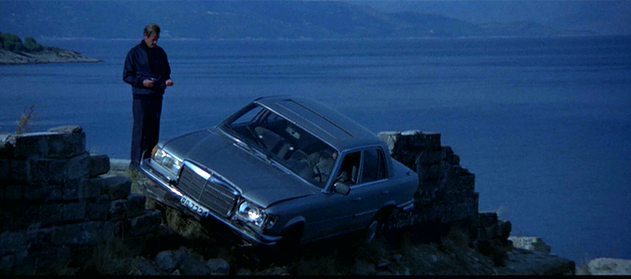
From For Your Eyes Only (1981): James Bond kicks a car off a cliff
For Your Eyes Only is far and away Roger Moore’s best Bond film, a grounded, action-packed follow-up to the outer space extravaganza of Moonraker. The film features many great action scenes, particularly the final mountain climbing set-piece, which endures as another masterpiece of escalating suspense.
But in terms of character moments, Moore gets a great one in this movie.
Near the end of For Your Eyes Only, he fights a merciless assassin, Locque (Michael Gothard). Locque has been killing agents and Bond’s allies throughout the whole film, and now Bond finally has him cornered, his car perched on the edge of a rocky cliff.
In his car, Locque panics at his precarious predicament, but things get worse when Bond approaches, and tosses him a keepsake: the “Dove” pin Locque left behind at several crime scenes.
Bond returns the pin to Locque….and then kicks the fucker’s car off the cliff.
Again, there’s nothing light or jokey about this moment. Bond is judge, jury and executioner, and he dispatches Locque with blunt, brutal finality. There are times for compassion and times for humor…and this isn’t one of them. Instead, Bond wordlessly metes out justice. He does so in one fluid movement.
This is the very moment, perhaps, when many Bond fans realized how ill-served Roger Moore had been by some of the Bond scripts. He was capable of being as tough, but rarely had the opportunity to flex that muscle. He shows here that he can capture Bond’s grace, and killer instinct…with perfect economy.

From Octopussy (1983): Bond explains to Octopussy (Maud Adams) how he treated her father.
In Octopussy, Bond travels to India and meets the mysterious smuggler called Octopussy on her private island. She asks him a question about an old case, and there’s every chance their meeting could go fatally wrong. Specifically, Octopussy asks if Bond remembers Major Dexter Smythe.
Bond does remember.
Turns out he was a British agent turned thief who Bond was tasked with bringing into custody. But instead of merely arresting the criminal, Bond gave the man twelve hours to get his affairs in order. Rather than be publicly disgraced, the major took his own life.
Octopussy is his daughter, and she is grateful that Bond gave Smythe time to consider his fate, and avoid public disgrace for his family.
Once more, we are confronted with Bond’s code of ethics. He may be licensed to kill and serve Her Majesty’s Secret Service but he’s not a monster, and when he goes into the field, he interprets orders, rather than simply obeying them. As I wrote above, there are times for compassion, and this story reveals such a time.
Again, Moore is particularly good in this scene because Bond is in a bind. Lie to avoid consequences? Or tell the truth and face them?
He picks the latter, and earns Octopussy’s respect for his honesty (as well as historical behavior). The message is that this Bond is a man of honor.
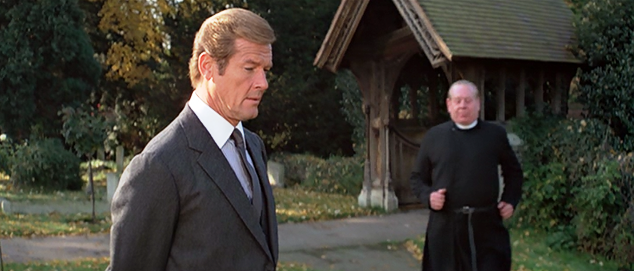
These days, the Bond films are serious, emotional affairs about a wounded warrior, and that’s all to the good. It’s easy to look back at the Bond films of the 1970s and decry them as being silly or inconsequential by comparison.
Many aspects of the films do fit that bill, but Sir Roger Moore was the 007 for my generation, and — in moments like the ones I enumerated above — I’m glad he was on the job.
Posted: 28th, February 2014 | In: Film, Key Posts | Comments (6)
Their Golden Years? Five Films About Your Greatest Heroes Growing Old
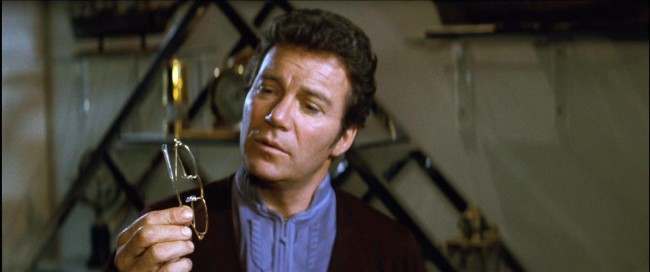
WITH J.J. Abrams’ Star Wars Episode VII in the pipeline comes the news that Harrison Ford, Mark Hamill, and Carrie Fisher will reprise their iconic roles in the George Lucas franchise for the first time in over thirty years, since 1983’s Return of the Jedi.
What impacts have time and ageing had upon courageous Empire-busting rebels Han Solo, Luke Skywalker, and Princess Leia?
Read the rest of this entry »
Posted: 22nd, February 2014 | In: Film, Flashback, Key Posts | Comments (2)
Portals of Light, Portals of Dark: The Yin and Yang of Contact (1997) and Event Horizon (1997)

EVERY now and then, Hollywood comes up with a good concept, and then competing studios rush to ruthlessly exploit it. Remember the summer of 1998, and dueling asteroid pictures Armageddon and Deep Impact?
Or 1988, the year of the “body switch” movie like Big, Vice Versa and 18 Again?
Read the rest of this entry »
Posted: 20th, February 2014 | In: Film, Flashback, Key Posts | Comments (4)
Piña Colliding: Yes, Rupert Holmes’ 1979 Hit Can Make Every Movie Better
“ESCAPE (The Pina Colada Song) by Rupert Holmes is great and it should be in every movie.”
So writes Carol Hartsell and Sean Crespo in an introduction to their Tumblr Piña Colliding. For those of you not au fait with Holme’s 1979 hit, here it is.
But can the song make everything it touches better? Let’s see:
Pina Colada 1: The Lion King
he Hitcher
The Silence Of The Lambs
Jaws
Posted: 20th, February 2014 | In: Film, Key Posts, Music | Comment
8 Reasons Why Every Movie Needs A Theme Song
A LOT of people make a lot of films, but sadly not all those films have kick-ass theme songs. This is a crying shame – AN ENORMOUSLY CRYING SHAME – because in an ideal world every film ever made would either begin or end (ideally both) with a song (not an instrumental, they don’t count) sharing a title with the film in question. Filmmakers, heed this advice. Why? Why, you say? Well…
– YOU MIGHT FINALLY GET THAT KUDOS YOU’VE BEEN AFTER
Read the rest of this entry »
Posted: 18th, February 2014 | In: Film, Flashback, Key Posts, Music | Comment
Nine Things You Didn’t Need To Know About Bill & Ted

TODAY marks the 25th anniversary of the original release of Bill & Ted’s Excellent Adventure, inarguably the best time-travelling-slackers-in-a-phonebox movie ever. Here are nine wholly unnecessary but non-bogus knowledge-bombs:
A BAND ON THE SOUNDTRACK DOESN’T EXIST

The song Two Heads Are Better Than One, the closing theme to B&TEE (as all the cool kids call it) is credited to a band called Power Tool. The thing is, there’s no such band. The song was performed by glam metal band Nelson, who co-wrote it with Dweezil Zappa. Nelson were in the middle of contract negotiations at the time so submitted it under a made-up name.
Read the rest of this entry »
How To Succeed With Brunettes And Blondes Prefer Gentlemen: 1967 US Navy Guides To Etiquette And Women
IN 1967, the Us Government taught the men How to Succeed with Brunettes. Produced by the US Navy, the film was aimed at the officer classes. Never agin would they fail in the brunette etiquette tests.
The holiday camp music and voice of paternalistic authority add to the sense of watching a well-played joke wrapped about a firm moral message.
Two things: couple are all boy-girl; and the only black face in view belongs to a waiter. This was 1967. Etiquette came before institutionalised racism. But let’s not spoil things. Let’s get down to the pulling:
Read the rest of this entry »
Because They All Look The Same: London Paper Mistakes Dwight Henry For Chiwetel Ejiofor

IN this episode of ‘They all look alike regardless of facial features, height, age, skin tones, hair voices and bodies’ the Lambeth Weekender salutes Forest Gate’s Chiwetel Ejiofor for his work on the film 12 Years A Slave.
Read the rest of this entry »
Posted: 13th, February 2014 | In: Celebrities, Film | Comment (1)
When You Wish Upon A Star: Exploring the Spirituality of Spielberg’s Close Encounters of the Third Kind (1977)

THE second-highest grossing film of 1977 (right behind George Lucas’s Star Wars) was Steven Spielberg’s Close Encounters of The Third Kind, a science fiction film concerning mankind’s first official contact with alien life-forms.
Close Encounter’s narrative also involves the mystery behind alien abductions and the truth regarding a government conspiracy to keep the existence of UFOs a secret.
Throughout the film Spielberg cross-cuts between two major plot-lines: a scientist’s (Francois Truffaut’s) efforts to develop a language so as to communicate with the visiting aliens, and one blue-collar worker’s (Richard Dreyfuss) personal journey to better understand their uncomfortable — but growing — presence in his daily life…and inside his very head.
Importantly, Close Encounters of the Third Kind (1977) was described by Science Digest as a film that is “tantamount to faith.”
The same publication noted too that Close Encounters’ sense of faith, so “wondrous and thoroughly spiritual – is registered in nearly every frame, reaching a climax in its messianic ending.”(Joy Boyom, Feb 1978, p.17).
Similarly, Gregory Richards’ monograph, Science Fiction Movies (Gallery Books, 1984, p.61) contextualizes Spielberg’s disco-decade UFO epic “as more of a religious film than a science fiction one.”
So the primary question that viewers must reckon with regarding this cult classic is: why have so many reviewers contextualized the Spielberg film as one of an overtly religious nature? Does an understanding of the religious allegory open up new avenues for understanding this work of art?
Or contrarily, does the religious explanation of Close Encounters only serve to cloud the secular, humanist message beating at the movie’s heart?

Close Encounters as Religious Allegory
In part, the categorization of Close Encounters of the Third Kind as a film about spirituality and faith arises because Steven Spielberg’s movie so abundantly features what David A Cook, author of Lost Illusions: American Cinema in the Shadow of Watergate and Vietnam, 1970 – 1979, calls “an aura of religious mystery.” (University of California Press, 2000, p.47).
Roy Neary — much like the apostle Paul on the road to Damascus according to Paul Flesher and Robert Torry in Film and Religion: An Introduction — experiences a kind of spiritual dawning or awakening.
In particular, Neary sees a UFO and hears the call of the aliens (transmitted via a telepathically implanted, subconscious “message” or “vision.”)
At first he does not understand the alien message. What is the meaning of the strange thoughts in his head? Why does he feel compelled to undertake a pilgrimage –– a journey to a location of great importance to one’s faith — to some mountain he has witnessed seen only in his mind?
Eventually, however, Neary surrenders to the vision, to his faith. He forsakes all his worldly belongings and connections — including his family — in a devoted (and perhaps mad…) attempt to understand why he has been “chosen” to hear this call from a (literally) Higher Power.
Clearly, Neary seeks communion with the message’s sender…with a stand-in for God. His quest in Close Encounters thus reflects Scripture and Romans in particular. “Faith comes from hearing, and hearing through the word of Christ.” Here, Neary has heard and honored that word, but it is the words of the aliens.
Neary’s hardship and trials are eventually vindicated. At last, he meets the aliens at the mountain of his vision (ironically at a place called Devil’s Tower), and then watches as a version of the second coming of Christ is re-enacted before his eyes.
According to Flesher and Torry (Abindgon Press, 2007, p.200), the returned abductees whom the aliens release from their landed mother ship symbolically represent the dead rising, or the resurrection of the dead as foretold in Scripture. And furthermore, the ascent of the alien craft to outer space with one of the faithful (Neary) ensconced aboard it similarly represents the Christian rapture, the trip to Heaven, essentially.

Even the physical appearance of the aliens in Close Encounters might be readily interpreted as strongly reflecting Christian apotheosis.
In form, the extra-terrestrial bodies “have no clear blemishes or gender, suggesting that superior beings transcend the normal categories of physical existence and approach the ethereal qualities associated with spirits and angels,” notes scholar Eric Michael Mazur, (Encyclopedia of Religion and Faith (ABLC-CLIO, LLC 2011, page 388).

In his final ascent to the stars, to Heaven, Roy Neary is wholly affirmed in his unyielding faith and belief in the vision he received, over his wife’s cynicism and stubborn skepticism, and over the U.S. Government’s attempt to “control” the meeting of man and alien.
In some sense, Close Encounters is all about taking a leap of faith, and that very idea finds resonance in one of Spielberg’s compositions. Confronted with the government lie about a deadly and toxic nerve gas spill in Wyoming (near Devil’s Tower), Neary chooses to “believe” his own narrative instead. He rips off his protective gas mask and breaths the purportedly contaminated air. But he is proven right…he survives, and his faith is replenished.
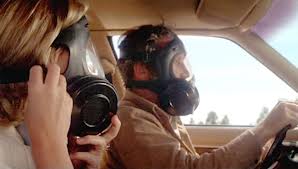
Given the alien angels, the metaphor for the Second Coming and even this leap of faith, the overall effect, therefore, of this cinematic journey is indeed, well, rapturous.
Strangely, however, there is a dark aspect to this story of religious awakening that one must also weigh.
While it is true that Roy Neary transitions from an unhappy and spiritually bereft life to one of faith and purpose, the cost of such knowledge of God (or God surrogate, in this case) is his very family. In the act of proving his faith and his worthiness of being “born again” in the stars, Roy abandons his family on Earth. This abandonment is literal, not metaphorical.
The non-believers — including his children — get “left behind” to toil in the world without his guidance or even presence. And again, the message could be interpreted as strongly religious.
If you don’t “believe,” you don’t get saved.
Lastly, even Close Encounters’ famous tag-line “We Are Not Alone,” could be easily parsed in a religious, “God is my co-pilot” sense.
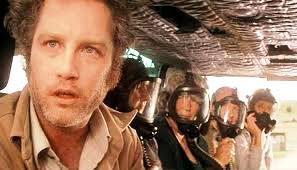
Close Encounters as a Secular Film about Self-Fulfillment
An alternate reading of Close Encounters suggests this cinematic work of art from Spielberg is actually a humanist film, the secular tale of a man who chooses to no longer be enslaved to society’s destructive constructs (including government, career, and family), and to follow his own individual path instead.
The story, again, is of Neary breaking free of constraints, but the breaking free in this reading is from a society that lies, cover-ups, and demands his perpetual unhappiness for its continuance.
The fact that Spielberg plays the song “When You Wish Upon a Star” at the conclusion of Close Encounters of the Third Kind is the primary support for this reading.
One lyric in that composition suggests a direct rebuke of faith, or religious identification. When you wish upon a star it “makes no difference who you are,” the song goes. In other words, you need not be affiliated with any particular group or belief system if you hope to achieve your dreams. You need not believe in God or a higher power. Instead, if you must merely “wish” and voice your “dreams,” you will be rewarded for following the best angels of your — human — nature.
In terms of history, Close Encounters of the Third Kind followed closely on many frissons in American politics, and this context, likewise, suggests a more humanist reading.
President Richard Nixon had been toppled in the Watergate Scandal in 1974, for example. His resignation and culpability in illegal activity suggested that “faith” or “belief” in the pillar of leadership was not such a good idea.
Similarly, the Vietnam War had ended in ignominy for the U.S. in 1975. The cause that so many Americans fought for (and died for…) was lost, and this very idea seems reflected in Close Encounters’ final scene.
There, a line of carefully vetted and approved government officials (surrogates for soldiers in Vietnam?) are overlooked by the aliens in favor of the “Everyman,” Roy Neary.
By contrast to these seemingly emotionless, expressionless, thoughtless drones, he is a man who chose explicitly not to believe the fairy tales his government was peddling. He has thus established his independence and his resourcefulness outside of Earthly and national considerations.
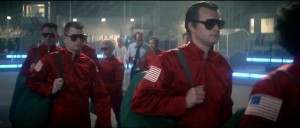
In this reading, the “leap of faith” of taking off the gas mask is actually the dawning awareness that — because of Watergate and Vietnam — the U.S. Government could no longer be trusted, or be considered an agent for honesty.
But again, in this reading of Close Encounters, one must reckon with Neary’s pure selfishness, his very questionable decision to leave his children and wife behind for his own individual “self-fulfillment.” And again, one must note that very idea of “sweet fulfillment” is explicitly voiced in the lyrics to the song “When You Wish Upon a Star.”
Yet I would suggest that Neary’s act of leaving his family (and his government, and his job…) behind in 1977 would not have been looked at by many audience members as purely a bad thing.
One must recall that the 1970s was determinedly the decade of the “self,” a fact reflected in the hedonism of disco music, and the blazing ascent in popularity of the “self-help” book genre. Popular buzz-words of the day included “self-realization” and — sound familiar? — “self-fulfillment.”
Yet as the movement of “self” grew in the late 1970s, many people were concerned that the new ethos was merely one of “self-involvement. The consumption-oriented life-style of immediate gratification soon gave rise to President Carter’s notorious 1979 “Crisis of Confidence” speech, which warned against judging success on material wealth rather than intrinsic human qualities of character and morality.
Meanwhile, the nation kept building more shopping malls, and imagined worlds futuristic (Logan’s Run) and apocalyptic (Dawn of the Dead) set at these new shrines to materialism. he 1978 Invasion of the Body Snatchers remake deals explicitly with this notion too, of the idea of people “moving in and out of relationships too fast” because they wanted to be happy and fulfilled, all the time.
But in a way, this is what Close Encounters concerns as well. Roy Neary helps himself, finally, to achieve his “dream,” even if his family can’t share in that dream. He gets what he wants — to go with the benevolent aliens to the stars — and in the late 1970s, this result is what qualified as a happy ending.

In his text How Fundamentalism Betrays Christianity (Three Rivers Press, 1997, page 291) author Bruce Bawer wrote of Close Encounters of the Third Kind that “salvation, meaning, and transcendence come down from the Heavens in a spaceship.” The question to ponder today involves the brand of salvation and transcendence.
Is it a spiritual reckoning, or a secular one that the alien spaceship brings with it?
It is a testament to Spielberg’s skill, perhaps, as a filmmaker and storyteller, that Close Encounters can be interpreted through two such opposite lenses or world-views.
Posted: 12th, February 2014 | In: Film, Flashback, Key Posts | Comments (3)
Stairway To Heaven? Six Genre Movies That Depict The After-Life

THE greatest unanswered question of human life is, paradoxically, about death.
What follows our duration on this mortal coil?
Read the rest of this entry »
Posted: 11th, February 2014 | In: Film, Flashback, Key Posts | Comments (2)
Childhood’s End: The Five Most Terrifying Movies Made From A Child’s Perspective

ALFRED Hitchcock once remarked that every person understands fear, because everyone was once a child. “After all,” he declared, “weren’t we all afraid as children?”.
According to the authors of Monsters under the Bed and Other Childhood Fears (Random House; 1993, page 1), “childhood is a time of many fears” and children between the ages of six and twelve “experience an average of seven different fears.”
Read the rest of this entry »
Posted: 6th, February 2014 | In: Film, Flashback, Key Posts | Comments (4)
12 Stupendous Movie Tagline Fails
THEY had one job. Just write a single sentence about a movie. It’s not quantum physics. After millions of dollars spent and many months of filming and editing, it comes down to the humble tagline writer to simply scrawl a few words together. Alas, this task is often too much to bear, and a movie poster is forever besmirched by a woefully inadequate blurb which undercuts all the hard work. Perhaps it’s not so easy to condense an entire film into a few words; whatever the case, here are a few examples where tag lines fail.
Loose Shoes (1980)
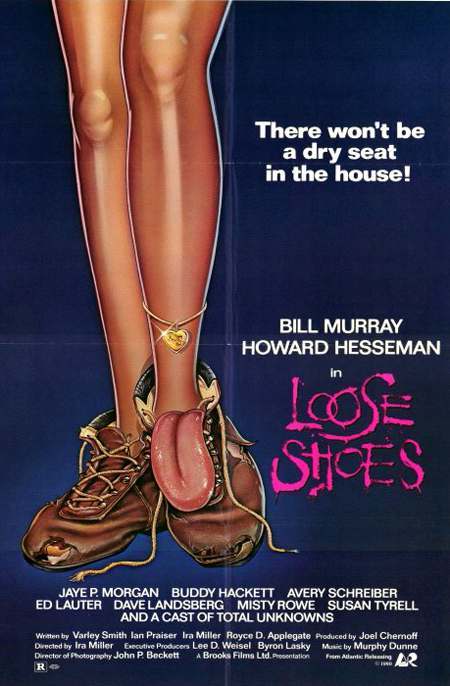
There won’t be a dry seat in the house.
Read the rest of this entry »
Posted: 5th, February 2014 | In: Film, Flashback, Key Posts | Comments (3)
Three Hats For Lisa: Swinging London And Sid James Gives The Greatest Musical Performance In Cinema History
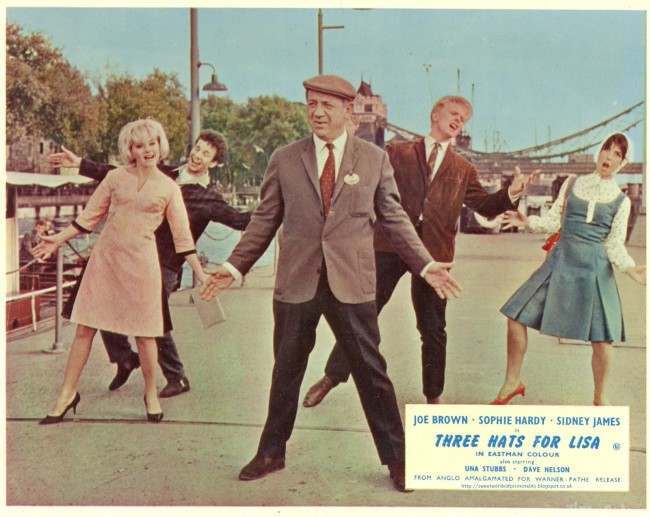
IS this the greatest musical performance in cinema history?
Joe Brown, French-born Sophie Hardy (who played the eponymous Lisa Milan), Sid James, Una Stubbs and Dave Nelson hit the big screen – in colour – with the 1964 release of Three Hats For Lisa.
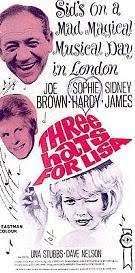
YouTuber RetrunerMan reveals the plot:
It’s a Swinging London romp as Joe (Johnnie) tties to help Lisa Milan, played by Sophie Hardy, to find three typically British hats for her collection. Probably not too difficult, only she wants to steal them instead of buy them. Oh, and one is a coppers helmet!
Read the rest of this entry »
Posted: 5th, February 2014 | In: Film, Flashback, Key Posts | Comment (1)
“They’re Dead. They’re All Messed Up” – How George A. Romero’s Night of the Living Dead Recreates the Unrest of 1968
THE AMC original TV series Mad Men (2007 – ) set its latest season against a disquieting historical backdrop: the turbulent events of the year 1968.
Specifically, Matthew Weiner’s award-winning period drama book-ended the season with allusions to two classic genre films from that year: Franklin Schaffner’s Planet of the Apes and Roman Polanski’s Rosemary’s Baby.
Both are excellent selections that showcase, respectively, global and spiritual apocalypse.
Yet there is another film — one released on October 1st, 1968 — that also represents perfectly the turmoil of America during that season: George A. Romero’s Night of the Living Dead.
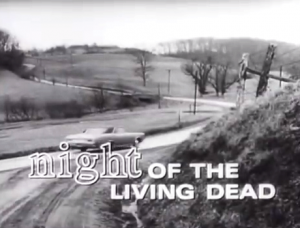
Today — due in large part to another AMC series, The Walking Dead (2010 – ), which is now airing the final portion of its fourth season — the zombie is arguably more popular a monster than ever before in genre history. Since Night of the Living Dead is its acknowledged spiritual and historical antecedent, the original film is thus eminently worthy of a re-watch in 2014.
Read the rest of this entry »
Posted: 3rd, February 2014 | In: Film, Flashback, Key Posts | Comments (2)
Watch Philip Seymour Hoffman Rock Three Parts In The Fifteen Minute Hamlet
IN 1995, Philip Seymour Hoffman played Bernardo, Horatio and Laertes in Todd Louiso’s 1995 version of Tom Stoppard’s 1976 play The Fifteen Minute Hamlet. Stoppard has enjoyed a hit with his Hamlet spin-off Rosencrantz and Guildenstern Are Dead. In this play, Stoppard strips down Shakespeare’s play into 13 minutes – plus a two-minute encore.
Read the rest of this entry »
Posted: 2nd, February 2014 | In: Film, Flashback, Key Posts | Comment
Back To The Future: Once An Awful Film, Now Set To Be An Awful Musical
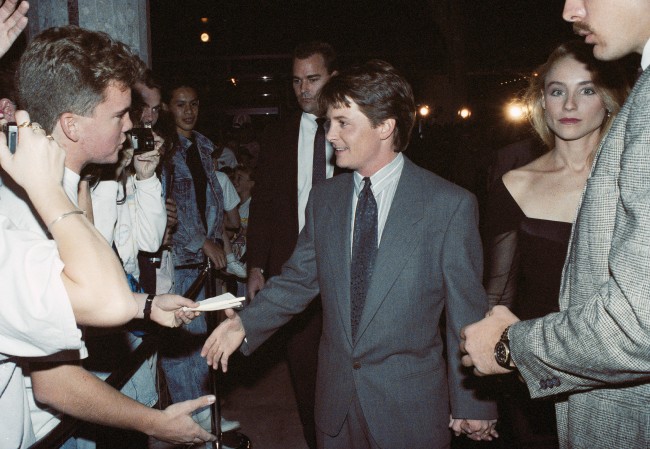
Actor Michael J. Fox, right, greets fans outside the theatre on Nov. 20, 1989 in Universial City, California where his latest film, “Back to the Future Part II,” premiered.(AP Photo/kevord djansezian)
HATE to break it to you ’80s nostalgiaists, but Back To The Future sucks. Basically, the whole story is about a boy who looks like he’s thirty, getting his own way like some brat, nearly getting off with his mum, stealing the invention of rock ‘n’ roll from the true innovators and gave birth to irritating people demanding hoverboards because we now live in the future.
And now, all the terrible action will be recreated in a stage musical, set to debut in London’s West End in 2015. Hopefully, it’ll be like Planet Of The Apes: The Musical, as seen in The Simpsons.
Good news for fans though as Robert Zemeckis, who co-wrote and directed the ’85 flick, will be reuniting with co-writer Bob Gale to recreate it for the stage.
Read the rest of this entry »
Posted: 31st, January 2014 | In: Celebrities, Film | Comment
The Hobbit: 10 Guaranteed Improvements
THE Hobbit is a long-winded, grinding, ego-driven borefest. But it can be improved. The sequel could be better. Here are 10 Tips:
Quentin Tarantino Ditches ‘Hateful Eight’ Thanks To Script Leak
UH-OH. Quentin Tarantino is declaring war on Hollywood after someone leaked the script for ‘Hateful Eight’. Only six people have seen the script itself, and Quentin is naming names. Bruce Dern is one and ‘Reservoir Dogs’ stars Tim Roth and Michael Madsen are two more.
He said: “I’m very, very depressed. I finished a script, a first draft, and I didn’t mean to shoot it until next winter, a year from now. I gave it to six people, and apparently it’s gotten out today. I like the fact that people like my shit, and that they go out of their way to find it and read it. But I gave it to six motherfucking people!”
Read the rest of this entry »
Posted: 22nd, January 2014 | In: Celebrities, Film | Comment
‘Devil Baby’ Spooks Unsuspecting New Yorkers
RECENTLY, a few well-meaning New Yorkers stopped to check on a crying baby in an abandoned stroller and got seriously spooked when a hideous demonic baby shot straight up from beneath the blankets.
Read the rest of this entry »
Hey Hey! It’s The Razzies! Grown-Ups 2 Could Sweep The Board
TOO frequently, the world of entertainment is very willing to pat itself on the back and gush all over itself about just how wonderful it has been all year.
However, with the shade that is the grisly business of an industry awards ceremony, comes the light of someone simply blowing a raspberry at the whole thing and waggling their arses.
Read the rest of this entry »
Posted: 15th, January 2014 | In: Celebrities, Film | Comment
British Board of Film Classification Gets All Wussy Over Horror Films
WITH cinema a feeble force in today’s world of Grab What You Want, When You Want It media, it seems those in charge are determined to make it all even weaker.
Cinema’s make you leave the house, sell you lousy food, half deafen you with badly mixed bass tracks on films, stink up your nostrils with bleach and, worst of all, force you to watch films with dreadful chattering strangers. All for a million pound per viewing.
Read the rest of this entry »
As Hitler’s Boxer Said To The Actress: Silent Anny Ondra Was Hitchcock’s Star Of Britain’s First ‘Talkie’
IN1929 almost everyone in the British film industry was convinced that the newfangled talking films would be nothing but a flash in the pan. But as the director Michael Powell once said of that time, “some flash, some pan”. Hitchcock knew before most that the era of silent films was over – “nobody wants ‘em,” he said to the aforementioned Powell, “they’re a dead duck”. So Hitchcock borrowed some German equipment and halfway through directing Blackmail he started to make a sound version of the same film and this, subsequently, became Britain’s first ‘talkie’.
Read the rest of this entry »
Posted: 12th, January 2014 | In: Celebrities, Film, Flashback, Key Posts | Comment
Tom Mix Was Hollywood’s Original Cowboy Tough Guy (Photo)
TOM Mix – January 6, 1880 – October 12, 1940 – was an American silent film actor who starred in hundreds of films.
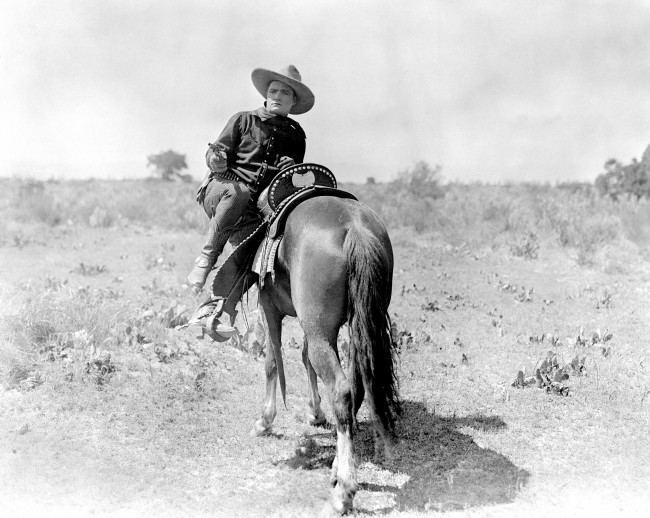
TOM MIX FIRES FROM HORSE: 1920
* In all, he made 336 feature films, produced 88, wrote 71 and directed 117. Tom made only 9 sound feature films and the 15-chapter serial “Miracle Rider.”
Read the rest of this entry »
Posted: 10th, January 2014 | In: Celebrities, Film, Flashback, Key Posts | Comment
Are Disney ‘Gender Bigots’? Meryl Streep Thinks So…
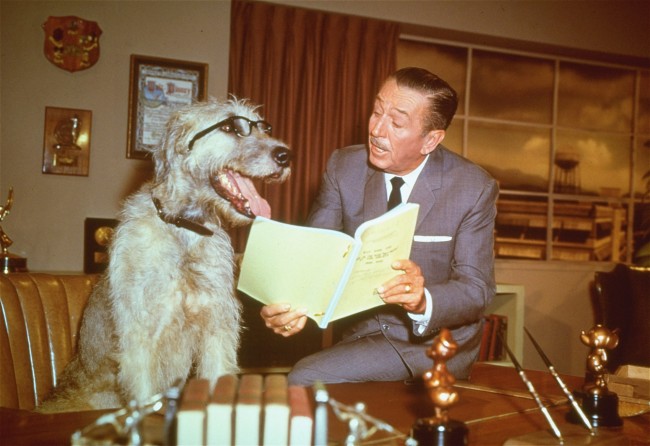
This is a December 23, 1965 photo of film animator and producer Walter Disney, in his office pretending to read a script with a dog, seated behind Disney’s desk. (AP Photo)
DISNEY are a problematic bunch at the best of times, and unfortunately for them, they’ve been very successful and for a long, long time, which means they’re subject to the kind of scrutiny that not many other organisations are.
Tough titty.
Read the rest of this entry »
Posted: 9th, January 2014 | In: Celebrities, Film, Reviews | Comment

